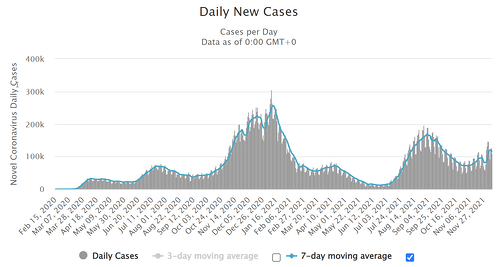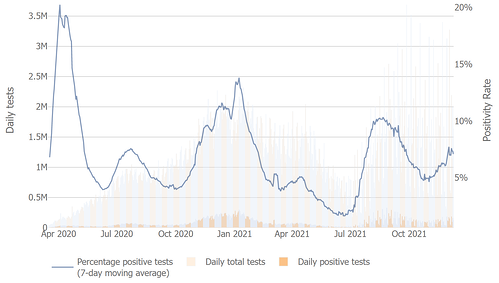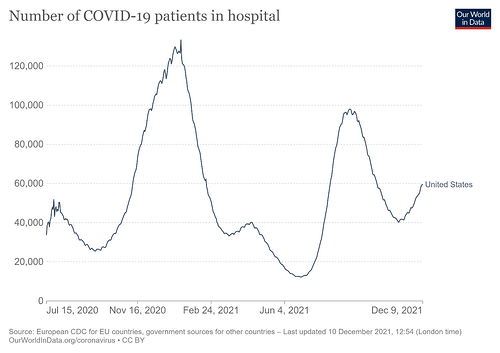Today, we're sharing Commonwealth Chief Investment Officer Brad McMillan's thoughts on the Omicron variant and whether it will impact economic recovery.
It has been going on two months since we last took a detailed look at the pandemic. Of course, a lot has happened since then. Between the winter wave of Delta, the emergence of Omicron, and the rising hospitalizations putting regional health care systems at risk again, there is a concern as to whether we are entering a third pandemic. I don’t think so, at this point. But let’s take a detailed look at where we are now and at the real question going forward—how bad will this get?
A Less Severe Winter Wave?
New cases per day. Let’s start with case growth. Looking at the chart below, we can clearly see the fall wave, driven by people moving indoors to the air conditioning in late summer, which took place primarily in the South. Then, after a brief recovery, we can see the fall wave driven by heat shift to a winter wave driven by cold, as people in the North moved into the central heating. After a brief dip at Thanksgiving, followed by a spike of faster growth as reporting caught up post-holiday (something we also saw last year), the winter wave continues.

Source:https://www.worldometers.info/coronavirus/country/us/
Looking at this data, there are a couple of points worth considering. Both the fall and winter waves were from the Delta variant, but the slope of case growth in the winter wave was slower than that of the fall wave. For whatever reason—more vaccinations in the northern states would be my guess—the winter wave doesn’t seem to be spreading as fast as the fall wave did. Although it is starting from a higher base, due to the fact that parts of the fall wave are still with us, that slower rate suggests a less severe winter wave. That is a good sign. It also suggests that even the more contagious Delta wave is being contained over time.
What’s also interesting is that while the Omicron variant is reported to be more contagious, there are signs it has been around here in the U.S. for several weeks, yet the case growth curve is still moderate compared with the earlier Delta waves. In fact, the most recent data suggests an actual slowdown in growth. Let me be clear: it is still too early to sound the all-clear, but this data at least raises the possibility that the Omicron wave will still be controllable, as earlier waves were, despite the higher transmissibility.
Testing news. Other data also supports that possibility. Just as with case growth, the positive test rates have risen in recent weeks but remain below the fall Delta wave high and seem to have peaked and even turned down a bit in the most recent data. If Omicron were indeed spreading as rapidly as reported, these downturns are a surprise.

Source: https://coronavirus.jhu.edu/testing/individual-states/usa
The infectiousness of Omicron seems well established. So one possibility is that Omicron is indeed spreading rapidly, but with current levels of immunity (from both vaccinations and natural exposure), much of the case growth results in mild enough cases not to enter the medical system. If so—and there is some limited data to suggest that might be the case—then the medical risks will still be largely from the existing Delta waves, with any incremental contribution from Omicron relatively mild. It’s too early to say, but the data so far leaves that possibility open.
Hospitalizations. That’s not to say that the risks are not real. As noted above, in many states, the winter wave has put health care systems under stress again, as shown in the chart below. The Delta winter wave has been enough to push hospitalizations up again. Even though they remain below previous peaks, they are still quite high. The risks and the damage are real. But these are risks we already know and have been dealing with from Delta and previous variants. Omicron adds to the picture, but so far at least has not dramatically changed it. Hopefully, that trend will continue, but we don’t know yet.

Economy and the Markets
From an economic perspective, however, the fact that the pandemic is still operating within previous parameters means that the country will remain open, and current trends are likely to continue. Labor demand has remained strong, despite a weak November report, with an average of more than 500,000 jobs created per month this year. Consumer spending has also grown substantially, while businesses remain confident and investing. From an economic perspective, the question about Omicron is whether it will generate enough disruption to derail the recovery. So far, it is not even close.
And markets are reflecting that view. After a brief pullback on worries about the Omicron variant, they have since moved back toward previous highs. So far, companies look likely to keep operating and making more money, and markets are reflecting that fact.
Progress Despite the Risks
Looking forward, the risks are real, but they have not shown up yet. We should have more clarity soon. If Omicron will change the trajectory of the pandemic here, any such change generated by Thanksgiving should show up in the next couple of weeks. Even more, the month or so after the Christmas holidays should give us more data. The risks remain real. But so far, we are making progress.